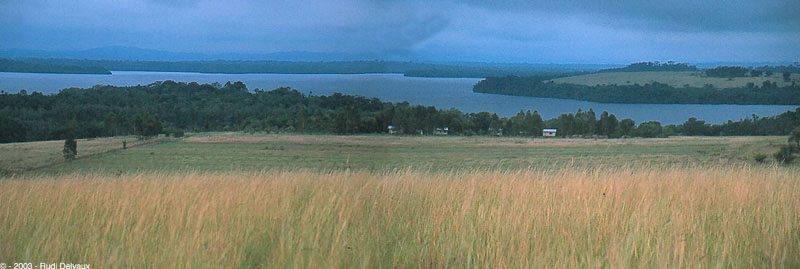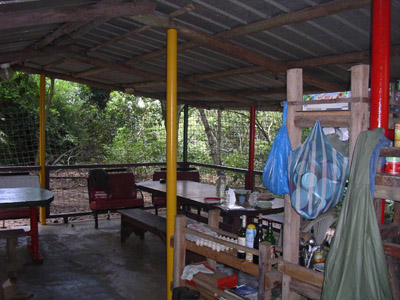|
fonctionnement english
Home
> H.E.L.P.
Project >
Operation
and sites in the Republic of Congo
•Operation
and sites in the Republic of Congo
Three sites in the Republic of Congo
 Ø The
antenna in Pointe Noire Ø The
antenna in Pointe Noire
H.E.L.P. Congo has a room where the communications (mails, phone) are managed,
administrative aspects or reception of the newcomers, like the voluntary
ones. It is also at this level that various materials are stored.
All that is necessary to the operation is conveyed at Pointe Noire, place where
all arrives from abroad where all is bought (food, for the personnel or the
chimpanzees), gas, building materials...
Ø the
Sanctuary of Conkouati (map)
The Sanctuary is located on the edge of the lagoon of Conkouati, approximately
180 km of Pointe Noire, within the National
Park of Conkouati-Douli. This site is made of three timbered
islands, with hutments out of wood and is accessible by the road. The islands
are different sizes: the island of Djembo also called the island of the small
is approximately 9 hectares wide; the island of Yombé is the
largest with 50 hectares. And the island of Pépère has a surface
of about 12 hectares.
It is the base where all the material, the supply and the people coming
from Pointe Noire, arrive.

Appart from the islands, this site has thus the plantation
of H.E.L.P.
Congo, buildings
for housing (up to 20 people and more) or the storage of the material and food.
It is also the base from which the boats bound for the camp leave the Triangle.
On location, water is provided primarily by rainwater, stored in cans and underground
tanks. Electricity is provided by solar panels. The use of power generating
unit remains specific. The kitchen is done with gas and wood fire. Flashlights
and oil lamps are very useful for displacements during the night.

Ø The
Triangle (map)
The Triangle is a forest belt of approximately 21 km², covered of diversified
forests (mangrove, marshes, forests with rapphiales, with marantacées,
noneasily flooded forests...). The richness of this site enable to slacken the
chimpanzees in a sufficiently rich site for their survival. The Triangle is
bordered in the south by the lagoon of Conkoauti, in the east by the Louvandzi
river and in the west by the Ngongo river, these three elements form a
ground triangle. In fact, the Ngongo river goes down from the Mayombe massif
and is divided into two branches, on the level of the northern top of the Triangle,
giving on one side a river called Louvandzi, and on the other side a second
river keeping the name of Ngongo. Right before this division, on the left
and right-hand side banks of Ngongo, the two camps of the site of the Triangle
are installed. Thus, there is no living on the Triangle itself. 
The installation of two camps on both sides of the river enables to have
a better view to observe the displacements of dugouts, primarily of poachers
but also makes it possible to occupy as well as possible the surfaces without
trees that are available. Indeed, no large tree was cut for the installation
of these camps. The hutments are all made out of wood, on piloti (zone easily
flooded) and all the materials were conveyed from Pointe Noire.
Water is provided by the rain stored in cans or it can be pumped in the river
during the dry season. Electricity is provided by solar panels or by a power
generating unit. Among the hutments, are several bungalow for housing, a kitchen
in each camp, a reserve and a laboratory. More than 20 people can be placed.
To move and be located in the forest, it was opened with the machete marked
out tracks or tailboards, on the Triangle and all the contiguous forest belts.
Supply and transport
Ø
All is conveyed of Pointe
Noire or almost. There are very little few agriculture on the zone. We can only
buy a few fish at the local level.
Transport is done by road or track, using truck or 4/4. The H.E.L.P.
Project have one of these vehicle. As soon as necessary, a camoin
is rented for large transport. In general, the supply take place during the
weekends.
Ø
To reach the Triangle, it
is necessary to use the boat ; as well as going on the islands or
to go to the various access points of the forest to go observe the chimpanzees
slackened. Thus, H.EL.P. Project has various motor boats, including one
large flat-bottomed for big transportation. Only the Louzandzi river is navigable because
it is maintained in shape by our teams. It takes about 1h to 1h30 to go from
the Sanctuary to the camp of the Triangle.
Communication
There is a HF radio set on each three site of H.E.L.P. Congo.
Our teams
Work is ensured in great part by Congolese employees (less than 6 on
the Sanctuary and sometimes up to 20 on the Triangle). They are assisted by
the voluntary, coming from all countries for often more than three months.
The management is ensured by a veterinary surgeon on the Triangle and a
chief of camp at the Sanctuary. The latter are in general volunteers of
long duration (at least six months), whose only expenses on the spot are taken
in charge.
Field work
Ø
 On
the Sanctuary, work is distributed between the care to the chimpanzees (daily
contribution of food complements), logistics (maintenance of the camp, inventory
control...) and the plantation. On
the Sanctuary, work is distributed between the care to the chimpanzees (daily
contribution of food complements), logistics (maintenance of the camp, inventory
control...) and the plantation.
Ø
On the Triangle, essential
work consists with the follow-up of the slackened chimpanzees. But it is also
necessary to maintain the tailboards, the river, the camps...
Ø
Days start early, often before
the rising of the sun (it is dawning towards 6 am).
On the Sanctuary, the heaviest works (exemple: plantation) are generally done
during the morning and at the end of the day, because of the heat. The follow-up
of the chimpanzees is often done all the day, from the rising to laying down
of the chimpanzees, the teams taking turns in middle of day. The night fall
towards 6 p.m. and the evening is often devoted to work on the data collected.
For more informations (in
particular on operation outside the Republic of Congo and the finnet
le financing)
Click on H.E.L.P.
Congo / H.E.L.P.
International / Financing
/ Sponsors
|

